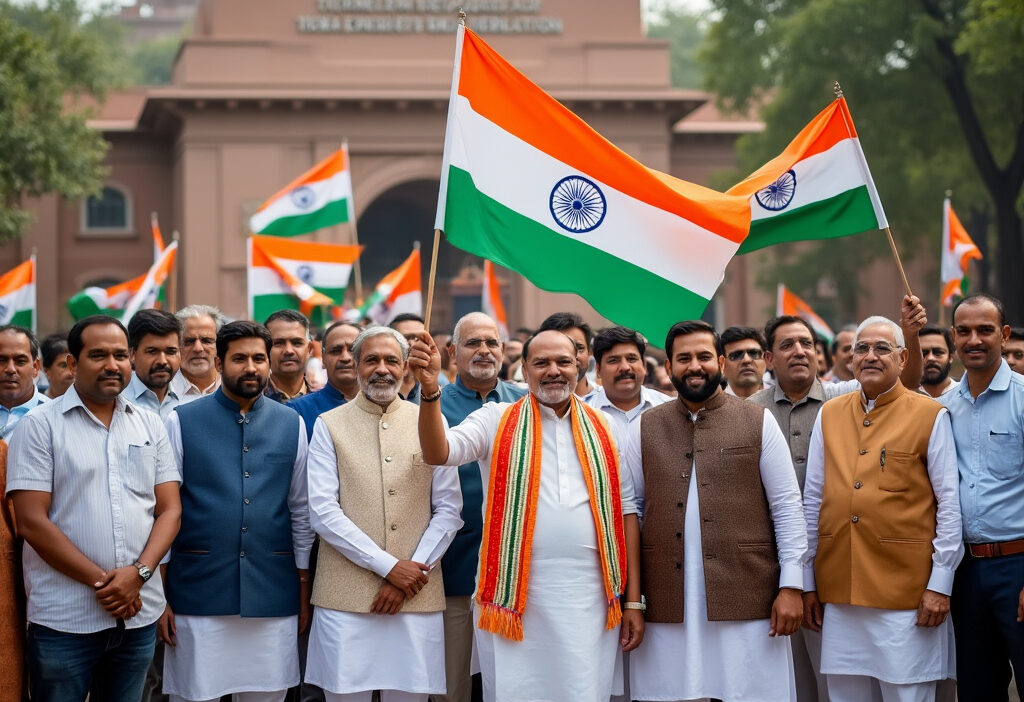Shifting Sands in Delhi Politics: The Rise of the Indraprastha Vikas Party
On May 17, 2025, Delhi’s political landscape underwent a seismic shift when 15 municipal councillors from the Aam Aadmi Party (AAP) resigned and founded the Indraprastha Vikas Party (IVP). This unexpected move not only spotlighted internal strife within AAP but also introduced a new player to Delhi’s political arena, setting the stage for the forthcoming municipal governance dynamics.
The Prelude to Defection
The mass resignation of 15 AAP councillors in May 2025 did not occur in isolation—it was the culmination of simmering tensions within the party’s municipal wing. While AAP had secured a third consecutive term in the 2025 Delhi Assembly elections, its performance in the municipal bodies told a different story. Councillors had grown increasingly frustrated with centralized decision-making, where key urban governance policies were dictated by the party’s top leadership without adequate grassroots consultation.
Reports of neglected infrastructure projects and delayed fund allocations further alienated local representatives, who bore the brunt of public anger. Many councillors felt sidelined, as their on-ground insights were routinely overlooked in favor of top-down directives. The final straw came when AAP’s high command reshuffled key municipal committees, sidelining experienced councillors in favor of loyalists with limited administrative experience.
Behind the scenes, murmurs of dissent had been growing for months, with disgruntled councillors privately discussing alternatives. The party’s inability to address their grievances—coupled with the perception that AAP was prioritizing state-level politics over municipal governance—created fertile ground for defection. By early 2025, the groundwork for a new political entity, later named the Indraprastha Vikas Party, was already being laid in discreet meetings among disillusioned AAP members.
Announcement of a New Political Chapter
On May 17, 2025, fifteen AAP councillors publicly announced their resignation, marking a seismic shift in Delhi’s political landscape. In a joint press conference at the Constitution Club, the dissenting leaders cited systemic failures in AAP’s municipal governance as their primary reason for leaving. They criticized the party’s centralized decision-making, alleging it marginalized grassroots voices and neglected local issues like sanitation, water scarcity, and infrastructure delays.
The councillors unveiled their new platform, the Indraprastha Vikas Party (IVP), framing it as a decentralized, ward-centric alternative. Their vision emphasized participatory governance, promising greater autonomy for councillors and direct community engagement. Key speaker Mukesh Goel stated, “Delhi needs leaders who listen, not dictate.” The IVP’s manifesto prioritized transparency, with plans for real-time public audits of municipal projects.
The announcement resonated with disenchanted AAP voters, particularly in underserved wards where service delivery had stagnated. Analysts noted the timing—just months before municipal elections—signaled a calculated move to capitalize on AAP’s weakening local appeal. The IVP’s emergence, rooted in pragmatic critiques rather than ideological divergence, positioned it as a formidable challenger in Delhi’s hyper-competitive politics.
Leaders at the Helm
The departure of 15 AAP councillors to the newly formed Indraprastha Vikas Party (IVP) was led by prominent figures, each with a distinct legacy within AAP. Mukesh Goel, a seasoned politician and former Leader of Opposition in the MCD, was instrumental in shaping AAP’s early municipal strategies. Known for his grassroots connect in North Delhi, his exit signaled a major blow to AAP’s organizational strength. Himani Jain, a two-term councillor from Rohini, brought a technocratic approach to urban governance, championing women’s safety and sanitation reforms. Her disillusionment with AAP’s centralization of power fueled her shift to IVP, where she now heads the policy drafting committee.
Hemchand Goyal, a former AAP treasurer, was critical in managing party funds during its rise. His financial acumen made him a key asset for IVP’s fundraising efforts. Other figures like Rituraj Govind, an education reform advocate, and Neha Bansal, known for her work in slum rehabilitation, joined the exodus, citing AAP’s neglect of local governance. Their new roles in IVP reflect a focus on decentralization, with Goel as working president, Goyal as finance head, and Jain spearheading civic welfare initiatives. This collective shift underscored a broader realignment in Delhi’s political landscape.
Rationale Behind the Resignation
The departure of 15 AAP councillors to the Indraprastha Vikas Party (IVP) was driven by deep-seated frustrations with the party’s functioning, particularly in the Municipal Corporation of Delhi (MCD). Many cited centralized decision-making as a key issue, where local representatives were sidelined in favor of top-down directives from AAP’s leadership. Councillors alleged that their on-ground expertise was ignored, leading to poor implementation of civic projects and a disconnect between policy and execution.
Another major grievance was the internal factionalism within AAP, where dissent was often suppressed. Councillors claimed that feedback on MCD mismanagement—such as delayed sanitation contracts and inefficient waste management—was dismissed, exacerbating public discontent. Some also pointed to financial irregularities in fund allocation, where promised resources for ward-level development never materialized.
The final straw for many was AAP’s refusal to address corruption allegations within its own ranks, creating an environment of distrust. Hemchand Goyal, one of the defectors, highlighted how transparency pledges were repeatedly violated, eroding morale. These systemic failures pushed the councillors toward IVP, which promised decentralized governance and accountability—a stark contrast to their AAP experience. Their exit underscores a broader crisis in AAP’s grassroots credibility.
The Ideology and Goals of Indraprastha Vikas Party
The Indraprastha Vikas Party (IVP) emerges as a response to the perceived stagnation in Delhi’s governance, positioning itself as a development-centric alternative to the AAP. Rooted in pragmatic urban reform, the IVP’s manifesto prioritizes decentralized decision-making, transparent municipal administration, and infrastructure modernization. Unlike AAP’s centralized model, the IVP advocates for empowering local councillors, addressing the very grievances that fueled the exodus of 15 AAP members.
Central to its ideology is a non-dogmatic approach to alliances, signaling willingness to collaborate with other parties—including the BJP or Congress—if it advances Delhi’s development. This flexibility contrasts sharply with AAP’s adversarial stance, offering a potential bridge in the fractured MCD. The IVP’s focus on apolitical governance—emphasizing sewage systems, waste management, and green spaces over partisan rhetoric—resonates with councillors disillusioned by AAP’s internal strife.
Critically, the IVP frames itself as a technocratic force, leveraging data-driven policies and citizen feedback loops, a departure from AAP’s populist tendencies. By championing hyper-local solutions, the party aims to reclaim trust in municipal leadership, filling the vacuum left by AAP’s perceived neglect of grassroots concerns. This strategic pivot could redefine Delhi’s political landscape, as explored in the next chapter.
Political Implications of the Split
The departure of 15 AAP councillors to form the Indraprastha Vikas Party (IVP) has sent shockwaves through Delhi’s political landscape, with immediate and long-term implications. For AAP, the split exposes internal fissures and raises questions about its ability to retain grassroots loyalty, particularly in municipal governance. The loss of seasoned councillors weakens AAP’s grip on the Municipal Corporation of Delhi (MCD), where every seat is critical for policy implementation. This defection also risks eroding public trust, as voters may perceive AAP as unable to manage dissent or deliver on promises.
For Delhi’s political scene, the IVP’s emergence introduces a third force capable of disrupting the AAP-BJP binary. The IVP’s development-centric agenda, as outlined in the previous chapter, could attract disillusioned AAP voters and even moderate BJP supporters, altering electoral calculations. In the MCD, the IVP’s presence may force AAP and BJP into unexpected alliances or competitive populism to counter its appeal. Future elections, including the 2025 MCD polls, could see tighter races, with the IVP potentially playing kingmaker or even securing a decisive role if it consolidates anti-incumbency sentiment. The split, therefore, isn’t just a momentary setback for AAP—it’s a potential reconfiguration of Delhi’s political dynamics.
Reactions from the AAP Leadership
The AAP leadership responded to the defection of 15 councillors with a mix of defiance and introspection. Senior leaders, including Delhi Chief Minister Arvind Kejriwal, downplayed the significance of the exodus, framing it as a minor setback rather than a systemic failure. However, internal discussions revealed concerns about growing dissent within the party’s grassroots ranks. AAP acknowledged some of the issues raised by the defectors, such as allegations of centralization of power and lack of consultation with local representatives, but dismissed claims of corruption as baseless.
To counter the political fallout, AAP announced a two-pronged strategy:
- Grassroots outreach: Accelerating direct engagement with ward-level workers to address grievances and rebuild trust.
- Narrative control: Highlighting the IVP’s ties to rival parties, framing the split as a BJP-backed maneuver to weaken AAP’s anti-corruption image.
Despite public confidence, the leadership privately scrambled to prevent further defections, offering assurances of greater autonomy to remaining councillors. The party’s ability to stem the tide will depend on whether these measures address the underlying discontent—or if the IVP’s emergence marks the beginning of a deeper crisis.
Public and Political Reactions
The departure of 15 AAP councillors to form the Indraprastha Vikas Party (IVP) has triggered mixed reactions across Delhi’s political spectrum. Public sentiment appears divided, with some viewing the defections as a betrayal of AAP’s anti-corruption ethos, while others see it as a necessary shake-up to address local grievances. Social media trends suggest a cautious curiosity about the IVP’s agenda, particularly its focus on hyper-local governance and promises of greater transparency.
Opposition parties have seized the opportunity to amplify AAP’s internal turmoil. The BJP has framed the exodus as proof of AAP’s “failed governance model,” while Congress has cautiously welcomed the IVP, hinting at potential alliances if the new party gains traction. Political analysts speculate that the IVP could disrupt the traditional AAP-BJP binary in the MCD elections, especially if it secures support from disenchanted AAP voters and independent candidates.
The competitive landscape now hinges on whether the IVP can consolidate its base before the polls. Key factors include its ability to:
- Leverage defectors’ grassroots connections in their respective wards
- Differentiate its platform from AAP’s without alienating core voters
- Negotiate tactical alliances with smaller parties or independents
The coming months will test whether the IVP can translate this upheaval into a lasting political realignment.
Future of the Indraprastha Vikas Party
The Indraprastha Vikas Party (IVP) enters Delhi’s political arena with a mix of opportunity and uncertainty. Its immediate prospects hinge on leveraging the defection of 15 AAP councillors, which provides a ready-made organizational base and local credibility. However, the IVP’s long-term success depends on its ability to differentiate itself from AAP and other rivals while addressing Delhi’s pressing civic issues—water scarcity, waste management, and urban infrastructure.
The party’s initial resource advantage—experienced leaders and grassroots connections—could help it carve a niche, but challenges loom. Financial constraints, media scrutiny, and potential defection risks threaten stability. To solidify its presence, the IVP must adopt a multi-pronged strategy:
- Policy differentiation: Focus on hyper-local governance reforms, distancing itself from AAP’s broader populist agenda.
- Coalition-building: Forge alliances with smaller parties or disaffected BJP factions to expand its electoral reach.
- Digital mobilization: Use data-driven campaigns to target young voters and marginalized communities underserved by existing parties.
If the IVP can balance pragmatism with a clear ideological vision, it could disrupt Delhi’s political duopoly. However, missteps in candidate selection or failure to deliver early wins in municipal projects could relegate it to obscurity. The next 12 months will be critical in determining whether the IVP evolves into a viable alternative or fades as a fleeting rebellion.
Conclusion and Outlook
The departure of 15 AAP councillors to join the Indraprastha Vikas Party (IVP) marks a pivotal moment in Delhi’s political landscape, signaling a potential realignment of municipal governance. This shift underscores growing discontent within AAP’s ranks and reflects broader frustrations with centralized decision-making and unfulfilled promises. The move not only weakens AAP’s grip on local bodies but also bolsters IVP’s credibility as a viable alternative, leveraging disenchanted leaders with grassroots experience.
For Delhi’s citizens, this realignment could mean a more competitive municipal arena, with IVP pushing for hyper-local agendas and greater accountability. However, the transition also risks short-term instability as IVP consolidates its newfound strength. The long-term impact hinges on whether IVP can translate this momentum into effective governance, addressing pressing issues like sanitation, infrastructure, and civic participation.
The evolution of Delhi’s municipal governance now hinges on IVP’s ability to differentiate itself from AAP, both in ideology and execution. If successful, this could usher in an era of decentralized, citizen-centric politics. If not, it may further fragment an already polarized system, leaving voters disillusioned. The coming months will test whether this shift represents genuine change or merely a reshuffling of political loyalties.

Conclusions
The formation of the Indraprastha Vikas Party by 15 former AAP councillors marks a pivotal moment in Delhi’s political discourse, hinting at a new direction for municipal governance and development. This event not only showcases the fluidity of political loyalty but also sets the stage for an intriguing political landscape in Delhi, with potential shifts in power dynamics and strategies as the city heads towards future elections.



